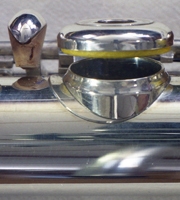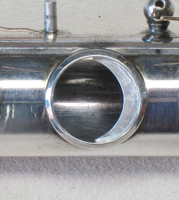Many flutes made by Louis Lot were built at A=435 Hz. Trying to play these flutes at A=440 Hz by pushing the headjoint all the way in, or worse yet, cutting the headjoint, makes the scale almost impossible to play consistently. While notes in the right hand might be in tune at the higher pitch, notes in the left hand become exceedingly sharp, as are all notes in the third register.
Verne Powell built his flutes at A=440 with a somewhat longer scale than is common today. The result is a flute that is not comfortable to play at pitches of A=442 and higher. Many players will often have to sacrifice tone quality to play in tune.
Fortunately, there is a very easy solution to retune an instrument to play consistently in tune with itself. Moreover, this solution is also reversible, which will preserve the integrity and value of vintage instruments.
The traditional technique to

Gary Lewis, however, developed another accurate and effective retuning method that does not permanently alter the instrument. The result is a flute with an excellent scale that will still be considered an authentic original instrument. He has retuned Louis Lot, Rive, and Bonneville instruments that have been played professionally by a number of players with excellent results.
First, he calibrates the lowest note of the body (typically low D or Eb) to A=440, A=442 or A=444. This often means pushing the headjoint in further than normal. At this position, notes in the left hand are very sharp, while the notes in the right hand and lower registers are closer to the desired pitch. He then measures all aspects of the flute and uses computer models to calculate the required alterations to bring the entire flute to the desired scale.
Once the results are determined, Gary prepares silver wedges in the proper sizes and shapes and set them in place with cyanoacrylate adhesive. These wedges bring down the pitch of the upper notes, shortening the scale, and adjusting all toneholes to agree with the lowest note of the original scale at A=440 (or the desired pitch).
The results are both precise and economical compared to the traditional method of retuning an instrument. The changes are also reversible, which preserves the value of the vintage flute.

Flutes can also be retuned to lower pitches, such as adjusting the scale of A=444 to play more effectively at A=440. The retuning process is the same.
Time at the workshop: 2 weeks.
Fee: $950 for all models.
